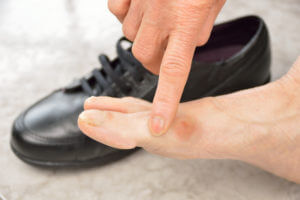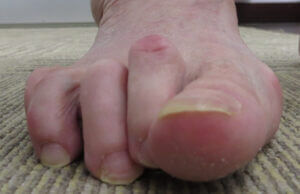When is surgery indicated for the bunion?
 When is surgery indicated for the bunion? is the most common question asked? Surgical referrals should only be made when conservative approaches have failed.
When is surgery indicated for the bunion? is the most common question asked? Surgical referrals should only be made when conservative approaches have failed.
This introductory article covers some of those important indications for managing the bunion. Conservative care aims to deal with three elements. These elements include alignment (A) the deformed part of the bunion. The integrity of tissue (I) and pain as in discomfort (D). This may come from the skin.
Each of these three elements will influence how we walk. The importance of how easy we find movement comes under the term mobility (M). These elements can be referred to as A.I.D
When you might be referred for Bunion Surgery
The following considerations will represent the standard questions that a professional might consider when discussing surgery with you.

Footwear needs to kept in good repair and bunion deformity often causes shoe distortion
Where mobility (M) is reduced this will limit our capacity to enjoy walking and other activities. Foot discomfort (D) caused by everyday shoes not fitting because of the alignment of our foot adds to the problem. Footwear education should be provided. This comprises checking our shoes for fit, design and suitability. So often old shoes are not replaced because they become old faithful.
Discomfort (D) levels of pain are assessed between 0-10. Once the pain scales to 3 upwards then clearly matters need investigating. Ask yourself what level of pain or discomfort you experience? How long does this pain last? Do you need to take medication for pain?

Hammertoes may be indicated for bunion surgery as a secondary feature
Secondary features affect each of the three components of alignment, the integrity of tissue and discomfort (A.I.D) A secondary feature means that the primary problem (the bunion) may well be causing additional foot deformity such as toe buckling (hammertoes). Skin problems such as corns in between the toes. Irreversible tissue concerns (I) may be associated with medical factors such as nerve sensory reduction associated with diabetes
Where conservative methods including the use of orthoses, splints and taping fail to assist with (A) alignment then surgery may be an option. Problems higher in the leg and body can be associated with poor alignment causing pain in the knee, hip and back. Podiatrists will be able to offer an assessment of the way that you walk.
Surgery should achieve all aims of A.I.D
Surgical risks from bunion surgery are varied and a fuller description can be found in the patient journey book Tollafield, DR. Bunion. Hallux Valgus. Behind the Scenes. 2019. pp 129-140. Available from Amazon books (E-book and paperback versions)
Cautions & Risks
Clearly do not have surgery to look better for cosmetic reasons. Likewise do not have surgery to embark on fashion statements. Be careful not to have surgery just because a parent or grandparent had the problem. Bide your time and seek advice from a professional. A bullet-point summary is listed below but it is not exhaustive. I wrote a book in 2019 which covers rare and common problems with bunion surgery Bunions Behind the Scenes.
If you do have surgery here are some of the aspects you need to be aware of:
- Reoccurrence of the deformity in 7-15% of bunion operations
- Failure to achieve what you want or need in 10-15% cases
- Stiffness in the big toe can be permanent
- You may be limited to shoes after surgery
- Increased pain can arise from scars, trapped nerves and transfer pain across the ball of the foot also known as metatarsalgia
 Do I need bunion surgery?
Do I need bunion surgery?
This has been a quick reference article for surgical referral for both the professional and lay reader. The content may be useful when patients consult their foot health professionals. You may also like to read my article on Bunion surgery when is the best age? You can also read what is a podiatric surgeon (UK) on this site. Another useful fact sheet covering surgery on the bunion can be downloaded showing risks and outcomes.
Thank you for reading “When is surgery indicated for the bunion” by David R Tollafield

Sign-up for here my regular FREE newsfeed
Published by Busypencilcase Communications. Est. 2015 for ConsultingFootPain




Trackbacks/Pingbacks